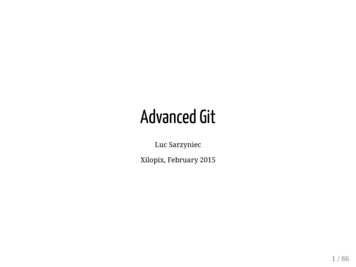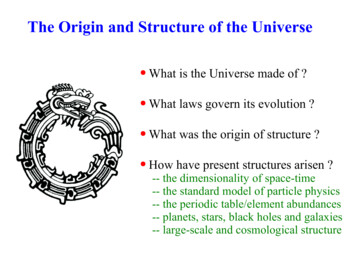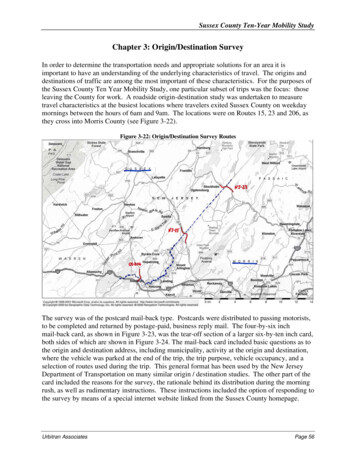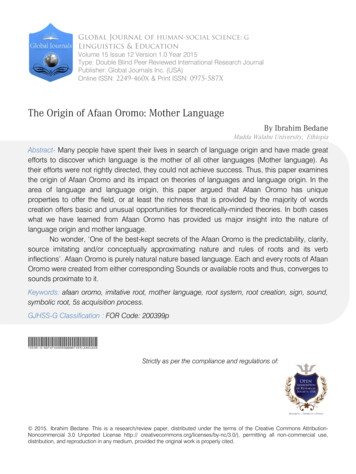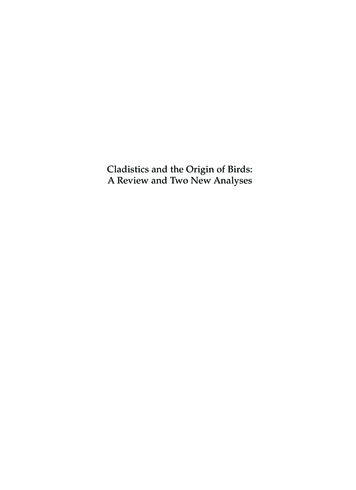
Transcription
Cladistics and the Origin of Birds:A Review and Two New AnalysesOM66 FM.indd 13/31/09 4:56:43 PM
Ornithological MonographsEditor: John Faaborg224 Tucker HallDivision of Biological SciencesUniversity of MissouriColumbia, Missouri 65211Managing Editor: Mark C. PenroseCopy Editor: Richard D. EarlesAuthors of this issue: Frances C. James and John A. Pourtless IVTranslation of the abstract by Lisbeth O. SwainThe Ornithological Monographs series, published by the American Ornithologists’ Union, has beenestablished for major papers and presentations too long for inclusion in the Union’s journal, The Auk.Copying and permissions notice: Authorization to copy article content beyond fair use (as specifiedin Sections 107 and 108 of the U.S. Copyright Law) for internal or personal use, or the internal orpersonal use of specific clients, is granted by The Regents of the University of California on behalf ofthe American Ornithologists’ Union for libraries and other users, provided that they are registeredwith and pay the specified fee through the Copyright Clearance Center (CCC), www.copyright.com.To reach the CCC’s Customer Service Department, phone 978-750-8400 or write to info@copyright.com. For permission to distribute electronically, republish, resell, or repurpose material, and topurchase article offprints, use the CCC’s Rightslink service, available on Caliber at http://caliber.ucpress.net. Submit all other permissions and licensing inquiries through University of CaliforniaPress’s Rights and Permissions website, www.ucpressjournals.com/reprintInfo.asp, or via e-mail:journalspermissions@ucpress.edu.Back issues of Ornithological Monographs from earlier than 2007 are available from Buteo Books athttp://www.buteobooks.com. Issues from 2008 forward are available from University of CaliforniaPress at http://www.ucpressjournals.com. For complete abstracting and indexing coverage forOrnithological Monographs, please visit http://www.ucpressjournals.com.Library of Congress Control Number 2009923609ISBN: 978-0-943610-85-6Issued 30 April 2009Ornithological Monographs, No. 66 viii 78 pp.Cover: If core maniraptoran theropod dinosaurs (Dromaeosauridae, Troodontidae, and Oviratorosauria)were actually flightless and flying birds that were more derived towards modern birds thanArchaeopteryx, then the hypothesis that birds are maniraptoran theropod dinosaurs would lose mostof its current support, and the origin of birds would have to be evaluated in the light of at least fourother hypotheses (see Fig. 3 on page 6).Printed by Allen Press on Forest Stewardship Council–certified paper. 2009 American Ornithologists’ Union. All rights reserved.OM66 FM.indd 23/31/09 4:56:50 PM
Cladistics and the Origin of Birds:A Review and Two New AnalysesbyFrances C. James1 and John A. Pourtless IV21Department of Biological Science, Florida State University, Tallahassee, Florida 32306, USA; and21327 High Road #K-1, Tallahassee, Florida 32304, USAORNITHOLOGICAL MONOGRAPHS NO. 66PUBLISHED BYTHE AMERICAN ORNITHOLOGISTS’ UNIONWASHINGTON, D.C.2009OM66 FM.indd 33/31/09 4:56:51 PM
Table of ContentsList of tables and figures. . . . . . . . . . . . . . . . . . . . . . . . . . . . . . . . . . . . . . . . . . . . . . . . . . .ABSTRACT. . . . . . . . . . . . . . . . . . . . . . . . . . . . . . . . . . . . . . . . . . . . . . . . . . . . . . . . . . . . . .INTRODUCTION. . . . . . . . . . . . . . . . . . . . . . . . . . . . . . . . . . . . . . . . . . . . . . . . . . . . . . . . .Definition of Aves . . . . . . . . . . . . . . . . . . . . . . . . . . . . . . . . . . . . . . . . . . . . . . . . . . . . .THE BMT HYPOTHESIS AND ALTERNATIVES . . . . . . . . . . . . . . . . . . . . . . . . . . . . . .The bmt Hypothesis. . . . . . . . . . . . . . . . . . . . . . . . . . . . . . . . . . . . . . . . . . . . . . . . . . . .The Neoflightless-theropod Hypothesis. . . . . . . . . . . . . . . . . . . . . . . . . . . . . . . . .The Early-archosaur Hypothesis. . . . . . . . . . . . . . . . . . . . . . . . . . . . . . . . . . . . . . . .The Crocodylomorph Hypothesis . . . . . . . . . . . . . . . . . . . . . . . . . . . . . . . . . . . . . . .The Hypothesis that Birds Evolved Twice. . . . . . . . . . . . . . . . . . . . . . . . . . . . . . . .CLADISTICS. . . . . . . . . . . . . . . . . . . . . . . . . . . . . . . . . . . . . . . . . . . . . . . . . . . . . . . . . . . . .METHODS . . . . . . . . . . . . . . . . . . . . . . . . . . . . . . . . . . . . . . . . . . . . . . . . . . . . . . . . . . . . . .Construction of Matrices . . . . . . . . . . . . . . . . . . . . . . . . . . . . . . . . . . . . . . . . . . . . .Methods of Analysis of the Matrices . . . . . . . . . . . . . . . . . . . . . . . . . . . . . . . . . . .RESULTS . . . . . . . . . . . . . . . . . . . . . . . . . . . . . . . . . . . . . . . . . . . . . . . . . . . . . . . . . . . . . . . .Reanalysis of the cnm Matrix . . . . . . . . . . . . . . . . . . . . . . . . . . . . . . . . . . . . . . . . .Analysis of the New Matrix . . . . . . . . . . . . . . . . . . . . . . . . . . . . . . . . . . . . . . . . . . . .Alternative Analysis of the New Matrix . . . . . . . . . . . . . . . . . . . . . . . . . . . . . . . .DISCUSSION . . . . . . . . . . . . . . . . . . . . . . . . . . . . . . . . . . . . . . . . . . . . . . . . . . . . . . . . . . . .Has the bmt Hypothesis Been Tested?. . . . . . . . . . . . . . . . . . . . . . . . . . . . . . . . . . .Unjustifiable assumptions of homology incorporated into data matrices . . . . . . . . . . . . . .Inadequate taxon sampling. . . . . . . . . . . . . . . . . . . . . . . . . . . . . . . . . . . . . . . . . . . . . . . . . .Insufficiently rigorous application of cladistic methods. . . . . . . . . . . . . . . . . . . . . . . . . . . .Insufficient tests of primary homology statements . . . . . . . . . . . . . . . . . . . . . . . . . . . . . . .Lack of statistical evaluation. . . . . . . . . . . . . . . . . . . . . . . . . . . . . . . . . . . . . . . . . . . . . . . . .Verificationist arguments. . . . . . . . . . . . . . . . . . . . . . . . . . . . . . . . . . . . . . . . . . . . . . . . . . .Introduction of ad-hoc auxiliary hypotheses. . . . . . . . . . . . . . . . . . . . . . . . . . . . . . . . . . . .Evaluation of Alternative Hypotheses. . . . . . . . . . . . . . . . . . . . . . . . . . . . . . . . . .Are predictions of the BMT hypothesis supported by our results? . . . . . . . . . . . . . . . . . . .Are some maniraptorans actually birds more derived than Archaeopteryx? . . . . . . . . . .Weakened support for the BMT hypothesis and theneoflightless-theropod hypothesis. . . . . . . . . . . . . . . . . . . . . . . . . . . . . . . . . . . . . . . . . . .Are alternatives to the BMT hypothesis compatible with the evidence? . . . . . . . . . . . . . . .Conclusions . . . . . . . . . . . . . . . . . . . . . . . . . . . . . . . . . . . . . . . . . . . . . . . . . . . . . . . . . .ACKNOWLEDGMENTS. . . . . . . . . . . . . . . . . . . . . . . . . . . . . . . . . . . . . . . . . . . . . . . . . . .LITERATURE CITED. . . . . . . . . . . . . . . . . . . . . . . . . . . . . . . . . . . . . . . . . . . . . . . . . . . . . .APPENDIX 1: SPECIMENS EXAMINED . . . . . . . . . . . . . . . . . . . . . . . . . . . . . . . . . . . . .APPENDIX 2: CHARACTER LIST FOR 242 CHARACTERS, NOTES,AND REFERENCES. . . . . . . . . . . . . . . . . . . . . . . . . . . . . . . . . . . . . . . . . . . . . . . . . . . . .Notes. . . . . . . . . . . . . . . . . . . . . . . . . . . . . . . . . . . . . . . . . . . . . . . . . . . . . . . . . . . . . . . . .APPENDIX 3: ANALYSIS OF CHARACTERS IN THE MANUS, CARPUS,AND TARSUS THAT WERE EXCLUDED FROM THE PRIMARYANALYSIS OF OUR NEW MATRIX . . . . . . . . . . . . . . . . . . . . . . . . . . . . . . . . . . . . . . .Manus . . . . . . . . . . . . . . . . . . . . . . . . . . . . . . . . . . . . . . . . . . . . . . . . . . . . . . . . . . . . . . . .Carpus. . . . . . . . . . . . . . . . . . . . . . . . . . . . . . . . . . . . . . . . . . . . . . . . . . . . . . . . . . . . . . . 8303235383939525261636364vOM66 FM.indd 53/31/09 4:56:51 PM
Disappearance of the avian ulnare and development of the pisiform . . . . . . . . . . . . . . . . . .Homology of the proximal carpals in Maniraptora . . . . . . . . . . . . . . . . . . . . . . . . . . . . . . .Distribution of proximal carpals in nonmaniraptoran theropods . . . . . . . . . . . . . . . . . . . .Homology of the radiale within Aves and between birds and theropods . . . . . . . . . . . . . . .Homology of the semilunate carpal within Aves . . . . . . . . . . . . . . . . . . . . . . . . . . . . . . . . .Homology of the semilunate carpal within the Theropoda and betweentheropods and birds . . . . . . . . . . . . . . . . . . . . . . . . . . . . . . . . . . . . . . . . . . . . . . . . . . . . .Identification of distal carpals without knowledge of digital identity . . . . . . . . . . . . . . . . .Tarsus: Ascending Process of the Astragalus. . . . . . . . . . . . . . . . . . . . . . . . . . . .APPENDIX 4: DATA MATRIX . . . . . . . . . . . . . . . . . . . . . . . . . . . . . . . . . . . . . . . . . . . . . .APPENDIX 5: NOTES ACCOMPANYING MATRIX ON SCORINGDECISIONS FOR CERTAIN TAXA . . . . . . . . . . . . . . . . . . . . . . . . . . . . . . . . . . . . . . . .65656566666768686976LIST OF TABLES1.2.3.4.5.6.Taxa included in our analysis and the principal references used for coding theircharacters . . . . . . . . . . . . . . . . . . . . . . . . . . . . . . . . . . . . . . . . . . . . . . . . . . . . . . . . . . . . . . . . . . . .Statistics from reanalysis of the 46-taxon 208-character matrix of Clark et al. (2002) . . .Statistics from analysis of our 79-taxon 221-character matrix with lengths ofmost-parsimonious trees (MPTs) when certain theropod taxa were constrainedto be within Aves as defined here . . . . . . . . . . . . . . . . . . . . . . . . . . . . . . . . . . . . . . . . . . . . . . . .Statistics from analysis of our 79 taxon 221 character matrix with lengths ofmost-parsimonious trees (MPTs) when taxa were constrained to match hypothesesfor the origin of birds (BMT birds are maniraptoran theropod dinosaurs) . . . . . . . . . . . .Five predictions of the BMT (birds are maniraptoran theropod dinosaurs) hypothesis . .Some of the major potential synapomorphies with birds that support the three majoralternative hypotheses for the origin of birds . . . . . . . . . . . . . . . . . . . . . . . . . . . . . . . . . . . . .91923232933LIST OF FIGURES1.2.3.4.5.6.7.8.9.10.Alternative relationships of birds and selected maniraptorans . . . . . . . . . . . . . . . . . . . . . . .Generally accepted phylogeny of the Archosauria including the topology of the BMThypothesis . . . . . . . . . . . . . . . . . . . . . . . . . . . . . . . . . . . . . . . . . . . . . . . . . . . . . . . . . . . . . . . . . . . .Five major hypotheses for the origin of birds . . . . . . . . . . . . . . . . . . . . . . . . . . . . . . . . . . . . . .Embryonic chicken wing bud at (A) 5.5 days of development and (B) 7.5 daysof development . . . . . . . . . . . . . . . . . . . . . . . . . . . . . . . . . . . . . . . . . . . . . . . . . . . . . . . . . . . . . . .Carpal cartilages in the chicken wing bud at (A) 9.5, (B) 11.5, and (C) 12.5 daysof development . . . . . . . . . . . . . . . . . . . . . . . . . . . . . . . . . . . . . . . . . . . . . . . . . . . . . . . . . . . . . . .(A) Distal and proximal tarsals of Albertosaurus, (B) a composite of the London and Berlinspecimens of Archaeopteryx, and (C) the Thermopolis specimen of Archaeopteryx . . . . . . .A 50% majority-rule summary of 500 bootstrap replicates of most-parsimonious treescalculated from the matrix reported by Clark et al. (2002) . . . . . . . . . . . . . . . . . . . . . . . . . . .As in Figure 7, but pruned to 24 taxa that represent all the major ingroup cladesof Clark et al. (2002) . . . . . . . . . . . . . . . . . . . . . . . . . . . . . . . . . . . . . . . . . . . . . . . . . . . . . . . . . . .A 50% majority-rule summary of 500 bootstrap replicates of most-parsimonious treescalculated from a matrix of 79 taxa including theropods, birds, nontheropod dinosaurs,and other archosaurs, pruned to 20 taxa . . . . . . . . . . . . . . . . . . . . . . . . . . . . . . . . . . . . . . . . . .As in Figure 9, but with Longisquama also pruned away . . . . . . . . . . . . . . . . . . . . . . . . . . . . .45613141517182020viOM66 FM.indd 63/31/09 4:56:51 PM
11.12.13.14.15.As in Figure 9, pruned to 35 taxa from 79, representing all major proposed sister groupsof birds . . . . . . . . . . . . . . . . . . . . . . . . . . . . . . . . . . . . . . . . . . . . . . . . . . . . . . . . . . . . . . . . . . . . . .As in Figure 11, but with the Maniraptora pruned away . . . . . . . . . . . . . . . . . . . . . . . . . . . .As in Figure 12, but with both maniraptorans and Longisquama pruned away . . . . . . . . . .A 50% majority-rule summary of 500 bootstrap replicates of most-parsimonious treescalculated from an alternative analysis to the analyses reported in Figures 9–13,using 242 instead of 221 characters, and pruned as in Figure 11 . . . . . . . . . . . . . . . . . . . . . .Skull of Longisquama insignis as preserved on the counterslab of the type specimen (left)and a reconstruction and interpretation of the cranial osteology (right) . . . . . . . . . . . . . . .2122222437viiOM66 FM.indd 73/31/09 4:56:51 PM
Ornithological MonographsVolume (2009), No. 66, 1–78 The American Ornithologists’ Union, 2009.Printed in USA.Cladistics and the Origin of Birds:A Review and Two New AnalysesFrances C. James1,3 and John A. Pourtless IV21Department of Biological Science, Florida State University, Tallahassee, Florida 32306, USA; and21327 High Road, no. K-1, Tallahassee, Florida 32304, USAAbstract.—The hypothesis that birds are maniraptoran theropod dinosaurs (the “BMT hypo thesis”) has become widely accepted by both scientists and the general public. Criticism has usu ally been dismissed, often with the comment that no more parsimonious alternative has beenpresented with cladistic methodology. Rather than taking that position, we ask here whether thehypothesis is as overwhelmingly supported as some claim. We reanalyzed a standard matrix of46 taxa and 208 characters from a recent paper by Clark, Norell, and Makovicky, and we foundstatistical support for the clades Coelurosauria and Maniraptoriformes and for a clade of birdsand maniraptorans. Note, however, that because the matrix contains only birds and theropods,it assumes that the origin of birds lies within the Theropoda. In addition to this problem, Clarket al.’s (2002) matrix contains problematic assumptions of homology, especially in the palate,basipterygoid, manus, carpus, and tarsus. In an attempt to avoid these two major problems andto evaluate the BMT hypothesis and four alternative hypotheses in a comparative phylogeneticframework, we followed the recommendations of Jenner, Kearney, and Rieppel by constructingand analyzing a larger but more conservative matrix. Our matrix includes taxa from throughoutthe Archosauria. When the ambiguous characters were excluded, parsimony analyses with boot strapping and successive pruning retrieved a weak clade of birds and core maniraptorans (ovirap torosaurs, troodontids, and dromaeosaurs) that also contained the early archosaur Longisquamaand was not unambiguously associated with other theropods. When the ambiguous characterswere included but coded as unknown where appropriate, the results were virtually identical.Kishino-Hasegawa tests revealed no statistical difference between the hypothesis that birds werea clade nested within the Maniraptora and the hypothesis that core clades of Maniraptora wereactually flying and flightless radiations within the clade bracketed by Archaeopteryx and mod ern birds (Aves). Additional statistical tests showed that both the “early-archosaur” and “cro codylomorph” hypotheses are at least as well supported as the BMT hypothesis. These resultsshow that Theropoda as presently constituted may not be monophyletic and that the verification ist approach of the BMT literature may be producing misleading studies on the origin of birds.Further research should focus on whether some maniraptorans belong within Aves, and whetherAves belongs within Theropoda or is more closely related to another archosaurian taxon. At pres ent, uncertainties about the hypothesis that birds are maniraptoran theropods are not receivingenough attention. Received 28 July 2008, accepted 25 January 2009.Resumen.—La hipótesis de que las aves son dinosaurios maniraptores terópodos (la teoría deBMT) ha sido extensamente aceptada por científicos y el público en general. Criticas en contra deesta hipótesis han sido usualmente rechazadas basandose en el hecho de que una alternativa masparsimoniosa no ha sido presentada usando metodologia cladística. Nosotros cuestionamos si lahipótesis esta realmente tan bien respaldada como ha sido indicado previamente. Se reanalizó unamatriz estándar de 46 taxones y 208 caracteres basados en el artículo publicado por James Clark,Mark Norrell y Peter Makovicky, encontrando resultados estadísticos positivos que respaldanlos clados de Coelurosauria y Maniraptoriformes y para los clados de aves y Maniraptora. Sinembargo, es importante notar que ya que la matriz contiene solamente aves y terópodos, esta3E-mail: james@bio.fsu.eduOrnithological Monographs, Number 66, pages 1–78. ISBN: 978-0-943610-80-1. 2009 by The American Ornithologists’ Union.All rights reserved. Please direct all requests for permission to photocopy or reproduce article content through the University ofCalifornia Press’s Rights and Permissions website, http://www.ucpressjournals.com/reprintInfo.asp. DOI: 10.1525/om.2009.66.1.1.1OM66 Text.indd 14/3/09 10:20:39 AM
2ORNITHOLOGICAL MONOGRAPHS NO. 66asume que el origen de las aves se sitúa dentro del grupo de los terópodos. Adicionalmente a esteproblema, las matrices de Clark, Norrell y Makovick también contienen problemáticas suposi ciones de homologia especialmente en el paladar, basipterygoid, manus, carpus y tarsos. Haciendoun intento en evitar estos dos grandes problemas y de evaluar la teoría de BMT y cuatro hipótesisalternativas en un marco filogenético comparativo, nosotros utilizamos las recomendaciones deJenner, Kearney, y Rieppel construyendo y analizando una matriz más grande y conservadora.Nuestra muestra incluye diferentes taxones representantes de los arcosaurios. Cuando lo carac teres ambiguos fueron excluidos, el análisis de parsimonia con bootstrapping y sucesivas podasprodujeron un débil clado de aves y del núcleo de los maniraptores (oviraptóridos troodóntidosdromaeosáuridos) que también contiene al arcosaurios Longisquama y no fue asociado sin ambig üedad con otros terópodos. Cuando los caracteres ambiguos fueron incluidos pero codificadoscomo desconocidos en casos apropiados, los resultados fueron virtualmente idénticos. Los resul tados de los pruebas Kishino-Hasegawa revelan que no hay una diferencia estadística entre lahipótesis que sustenta que las aves eran un clado perteneciente a los dinosaurious Maniraptores,y la hipótesis que propone que los clados de los dinosaurios Maniraptores eran radiaciones devoladores y no voladores dentro del clado bordeado por Archaeopteryx y aves modernas. Otrosanálisis estadísticos indican que las hipótesis del “ancestro-arcosaurio” y Crocodylomorpha sontan bien apoyadas como la hipótesis de BMT. Estos resultados demuestran que los terópodoscomo son constituidos hoy en día pueden no ser monofiléticos, y por lo tanto el enfoque verifica dor de la literatura de la BMT puede que produzca resultados erróneos sobre el origen de las aves.Mas estudios deberían enfocarse en descifrar su algunos dinosaurios maniraptores pertenecen alas aves, y si las aves pertenecen a la familia de los terópodos o si están relacionadas mas cercana mente a otro taxón de arcosaurios. Hasta el momento, no se le ha prestado mucha atención a lasincertidumbres que genera la hipótesis que indica que las aves son maniraptores terópodos.IntroductionThe current consensus hypothesis about theorigin of birds, often called “the theropod hy pothesis,” states that the sister clade of Aves isamong the five groups of maniraptoran thero pod dinosaurs (Oviraptorosauria, Troodontidae,Dromaeosauridae, Alvarezsauridae, and Ther izinosauroidea). The Troodontidae and the Dro maeosauridae, which together constitute theDeinonychosauria (Colbert and Russell 1969, Gau thier 1986, Norell and Makovicky 2004), are gener ally agreed to be the sister clade of Aves. The cladeuniting Deinonychosauria and Aves is sometimeslabeled Paraves (e.g., Turner et al. 2007). Aves is,therefore, deeply nested within Maniraptora andTheropoda. We will call this hypothesis the “BMThypothesis” (from “birds are maniraptoran thero pod dinosaurs”). By implication, birds are avianmaniraptorans, and the Oviraptorosauria, Troo dontidae, Dromaeosauridae, Alvarezsauridae, andTherizinosauroidea are nonavian maniraptorans.The BMT hypothesis was derived from of thework of John Ostrom (1973, 1975, 1976a, b). Ostromdescribed extensive osteological similarities be tween the skeletons of the dromaeosaurid Deinonychus and the earliest known bird, Archaeopteryx.He also drew the corollary inference that bipedal ism preceded the evolution of flight in birds. HeOM66 Text.indd 2argued that Archaeopteryx was primarily cursorialand incapable of powered flight and that the longforelimbs of dromaeosaurs like Deinonychus were“preadapted” for flight. The BMT hypothesis wasmore explicitly formulated on the basis of cladisticanalyses by Padian (1982), Gauthier and Padian(1985), and Gauthier (1986). Gauthier (1986) con cluded that his analysis of the large dinosaur groupSaurischia supported a sister-group relationshipbetween birds and either the Deinonychosauria orthe Dromaeosauridae alone.Since the publication of Gauthier’s influential1986 paper, many more data have become avail able. New Cretaceous birds are known fromSouth America, North America, Spain, Mongolia,and especially China (Padian 2004, Zhou 2004,and references therein). Remarkable bird-likemaniraptorans have been found in China, andothers are known from Mongolia and elsewhere(Weishampel et al. 2004, and references therein).Structures identified as feathers were reported inthe compsognathid Sinosauropteryx in 1996 (for adetailed description, see Currie and Chen 2001),and similar structures have since been reported inother theropod taxa (see Weishampel et al. 2004,and references therein). We now know that vari ous maniraptorans had combinations of derivedavian characters, including feathers, teeth withoutserrations, double-condyled quadrates, uncinate3/31/09 5:54:44 PM
origin of birdsprocesses on the ribs, laterally facing glenoid sock ets, retroverted pubes, and pygostyles (Weisham pel et al. 2004, and references therein; Kurochkin2006a, b). The BMT hypothesis has been supportedby a large number of cladistic and other studies(e.g., Padian and Chiappe 1998, Chiappe and Dyke2002, Clark et al. 2002, Paul 2002, Witmer 2002,Padian 2004, Weishampel et al. 2004, Xu 2006, andreferences therein). Some matrices now include100 taxa or more and several hundred characters(e.g., Sereno 1999, Holtz et al. 2004).Recent books (Dingus and Rowe 1998, Gau thier and Gall 2001, Chiappe and Witmer 2002,Currie et al. 2004, Weishampel et al. 2004, Norelland Ellison 2005, Chiappe 2007) summarize thesedata and assert that the BMT hypothesis hasrevolutionized our view of all Archosauria. Thehypothesis has even been hailed as one of themajor discoveries of 20th-century biology and aconfirmation of the validity of modern system atics (Padian 2001b, 2004; Prum 2002, 2003). Asnew data have become available, they have beenviewed as fully supportive (Padian and Chiappe1998; Chiappe and Dyke 2002; Prum 2002, 2003;Xu et al. 2003; Xu 2006), and, except for a few ca veats (Witmer 2002), further debate has been dis couraged (Padian 2001b; Prum 2002, 2003). Prum,for example, has called for the integration of or nithology as a subfield of dinosaur paleontologyand urged that textbooks be rewritten in accordwith the BMT hypothesis (Prum 2002, 2003).In spite of the general consensus in support ofthe BMT hypothesis, concern over some of its ele ments has persisted. Paul (2002) has argued thatthe reason some maniraptoran taxa possess somany derived avian apomorphies is that they are,in fact, secondarily flightless birds that are morederived than basal avian taxa like Archaeopteryx.Although Paul (2002) retained a theropod ances try for birds, support for his hypothesis wouldclearly complicate the consensus BMT view. Afew cladistic analyses have retrieved Alvarez sauridae (e.g., Perle et al. 1993, 1994; Chiappeet al. 1998) and Oviraptorosauria (Lü et al. 2002,Marya ńska et al. 2002) as birds more derivedthan Archaeopteryx, and other noncladistic stud ies have proposed avian status for various ovi raptorosaur (Elzanowski 1999, Lü et al. 2005) anddromaeosaur taxa (Czerkas et al. 2002, Burnham2007). These studies have provided support forelements of Paul’s (2002) hypothesis.The discovery of Microraptor, described as asmall basal dromaeosaurid (e.g., Xu et al. 2000,OM66 Text.indd 332003; Hwang et al. 2002, fig. 31), has challengedthe inference that bird flight originated in curso rial taxa. Additional material indicates that Microraptor was probably arboreal and that it wasat least able to glide and was probably capable ofpowered flight involving all four limbs (Xu et al.2003, 2005; Martin 2004; Feduccia et al. 2005, 2007;Burnham 2007). Indeed, Microraptor is strikinglysimilar to the tetrapteryx (four-winged) stage inavian evolution proposed by Beebe (1915, fig. 1;Xu et al. 2003). Such data suggest that the arbo real model for the origin of bird flight should bereconsidered. Among BMT proponents, Burgersand Chiappe (1999), Burgers and Padian (2001),and Padian (2001a, 2004) have retained the cur sorial rationale, but Chatterjee (1997), Witmer(2002), Zhou (2004), and Chatterjee and Templin(2004) have contended that an aboreal origin offlight can be incorporated into the BMT hypoth esis. This disagreement among BMT advocateshas not led them to question the basic tenets oftheir hypothesis.A major concern of critics of the BMT hypoth esis has been with the assumptions of homologyincorporated into matrices supporting it (e.g.,Martin 1991; Tarsitano 1991; Feduccia 1999, 2002).Inferences of homologies between birds andtheropods in characters of the carpus, manus,and tarsus have been challenged (e.g., by Burkeand Feduccia 1997; Feduccia 1999, 2002; Feduc cia and Nowicki 2002; Martin 2004; Feduccia etal. 2005, 2007). As argued by Czerkas et al. (2002),Feduccia (2002), Martin (2004), and Feducciaet al. (2005, 2007), the possible avian status ofsome maniraptorans could reopen the questionof avian ancestry outside of Dinosauria, despitePaul’s (2002) insistence to the contrary.In light of these ongoing concerns and thecontinuing accumulation of new and surpris ing data from the fossil record, Zhou (2004) ar gued that abandoning the debate concerning theorigin of birds was premature. We concur withthis assessment and wish to evaluate the BMThypothesis in the context of its alternatives. Ourgoals are (1) to assess whether the BMT has beenas critically tested as is claimed in most of theliterature and (2) to evaluate alternatives to theBMT hypothesis within a comparative phyloge netic framework, including the possibility thatsome currently nonavian maniraptorans actuallybelong within Aves. At a minimum, a simultane ous evaluation of all hypotheses for the originof birds would allow for the possible refutation3/31/09 5:54:45 PM
4ORNITHOLOGICAL MONOGRAPHS NO. 66Fig. 1. Alternative relationships of birds and selected maniraptorans. (A) The sister group of Aves is within themaniraptoran theropod dinosaurs as in Figure 2 (the BMT, birds-are-maniraptoran-theropod-dinosaurs topol ogy). (B) Selected maniraptorans are included within Aves.of the BMT hypothesis. First, we define Aves asused here. Then we describe alternatives to theBMT hypothesis, outline and discuss the ana lytical methods used here, and present two newanalyses. One analysis will be directed towardthe first goal of our study, and the other towardthe second.Definition of AvesFollowing Chiappe (1992), Chatterjee (1997),and traditional usage, we define Aves (birds) asa node-based clade that includes Archaeopteryx,modern birds, their most recent common ancestor,and all its descendants (Fig. 1A and B). The term“bird” refers to any member of this clade. The term“birdlike” describes any taxon whose morphologyis like that of members of the clade Aves. Note thatAves as here defined is equivalent to Avialae sensuGauthier (1986) and other workers (e.g., Perle etal. 1993, 1994; Norell et al. 2001; Clark et al. 2002;Maryańska et al. 2002). Whenever the statementis made that some maniraptorans may have beenbirds, the topology of Figure 1B is implied, inwhich these maniraptoran taxa are within the cladeOM66 Text.indd 4Aves as defined here, rather than the topology ofFigure 1A.The BMT Hypothesis and AlternativesAll authors agree that the origin of birds liesamong the Archosauria (sensu Benton 1999, 2004;Fig. 2). Archosauria is a clade of diapsid reptilesprincip
Cladistics and the Origin of Birds: A Review and Two New Analyses by Frances C. James1 and John A. Pourtless IV2 1Department of Biological Science, Florida State University, Tallahassee, Florida 32306, USA; and 21327 High Road #K-1, Tallahassee, Florida 32304, USA ORNITHOLOGICAL MONOGRAPHS NO. 66 PUBLISHED BY THE AMERICAN ORNITHOLOGISTS' UNION




